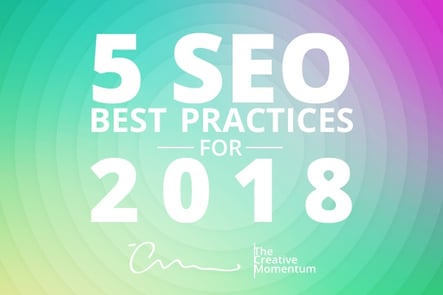
We’re now in Q4 of 2017. That means it’s time to start evaluating your website’s organic reach in 2017. Were you happy with your website’s position in Google’s SERPs? Did traffic increase or decrease? If you have not been ecstatic about your 2017 SEO results, consider these 5 SEO best practices in 2018.
1.Focus on Perfecting Your On-Page SEO
On-Page SEO will always be a major factor in Google’s algorithm because it provides a great user experience (UX). On-page SEO helps users by providing context to your content, organizing your content, and creating pathways for your users to easily navigate to other relevant content on your website. Here are 4 on-page SEO tips for you to follow:
1. Write compelling meta titles and meta descriptions
A few years ago, marketers were manipulating Google search results by keyword stuffing both meta titles and descriptions. Although it is important to keep the focused keyword in the title and description, be creative in how you deliver your titles and descriptions. Keyword stuffing focuses on the Google crawler but you should always focus on the user. Write meta titles and descriptions that are relevant and will entice users to choose you over your competitors.
Here’s an example of a keyword stuffed meta title and description:

Now here is an example of a user focused meta title and description:

Notice how the user focused meta title and description is very clear. You know exactly what the article is about.
2. Use Headers to Organize and Bring Context to Your Content
Imagine reading a newspaper that didn’t have headlines. You would have to read half of the article before you knew what it was about. Adding headers and sub-headers is like adding headlines to a newspaper. It gives context to your content before a user dives into it and it also helps organize all of the information. A common best practice is to work the keyword into the H1 header.
3. Create Internal Links
Creating internal links to help users better navigate to other pages of relevant content is best practice. The best practice is to not over optimize. Keep your links natural and don’t try to create too many internal links on one page.
4. Fix All 404 Errors
404s are UX killers. Nothing causes more bounces and exits out of a website than a 404 error. Reduce bounces and early exits by reducing the amount of 404 errors on your site.
2. Prepare Your Website For Mobile Users
During the summer of 2017, Gary Illyes, Google Webmaster trends analyst, said that there would be a ”big change” at the end of 2017 or possibly early 2018. Gary was talking about Google’s Mobile-First indexing. This means that Google will be prioritizing your site’s mobile version over the desktop version.
If your website is not ready for mobile users, though it won’t be penalized, it will be overlooked by Google’s crawlers.
Here are 3 things you can do to prepare for it:
- Make sure that your site is either designed for mobile or responsive.
- Reduce image size and optimize images to load faster.
- Create a blazing fast site to help with slower mobile connections.
3. HTTP vs HTTPS: Security Wins
It’s no longer debatable. HTTPS trumps HTTP. If you didn’t know, HTTPS in a URL means that the website or webpage has an SSL certificate. An SSL certificate lets users know that there is encryption between users and the website’s servers. That means that any type of transaction or communication between user and server is encrypted, which in layman's terms means information is kept secret.
Google Chrome is now notifying users when a website does not have an SSL certificate. Having an SSL certificate gives you a small SEO boost with Google and it also helps you build trust with your users.
4. Content is Still King in 2018
Content is King. Everyone has heard this and it’s a term has been used for a long time now. What does this mean? It means that you can have the cleanest on-page SEO, be optimized for mobile, be secured, but your SEO campaign will still be a failure if you aren’t providing value to your users. The reason why anyone searches for anything on the web is because they’re searching for information. Our job as marketers is to figure out what our audience is searching for and to provide information on the topic.
Too often, I see websites that act as business cards. You land on the website and it tells you 3 things: the name of the company, what they do, and how to contact them. Unless a user is near the end of the buying funnel, they probably won’t fill out a contact form. There also isn’t an incentive to visit the page other than to grab contact information.
Attracting customers through relevant and helpful content is what HubSpot calls, “inbound marketing.” If you do not have a strategy in 2018 to create content that brings value to your audience, you are losing out on an enormous amount of traffic. Great content draws in users. There’s only one thing better than great content: recurring great content.
As we’re 2 months from 2018, take a look at your content strategy. Focus on providing your users with a large amount of fresh content that’s valuable. Also, give your users what they want to consume, not what you want them to consume.
5. I lied. Content is NOT King. TRUST is the true King.
Since his election, President Trump has labeled a few news sources “fake news.” We have started to worry that what we are reading isn't real. By no means am I turning this article into a political one. I just want to show that authenticity, reputation, and trust matters more than ever.
Although content is important, content is only the means to the true goal, which is to make someone trust you enough to buy into what you’re selling. Trust is King and content is merely a trust builder.
Follow these steps to build trust:
- Create trustworthy shareable content: With the resources available on the internet, it is easy to snuff out when a company is creating untrustworthy or undependable content. As mentioned above, create valuable content. Valuable means that it is dependable.
On a side note, Redditors hate companies who self promote. These posts are often downvoted and the user is often called out to answer to the community. When you’re writing, stay true to providing value. Your content should be less self-promotion and more about helping users find the information that they’re looking for. - Be active on major social media channels and build a good following: As I do research on a product before I buy, I look at their social media profiles. An active profile means that they are serious about connecting with their customers. That builds a ton of trust.
- Build backlinks: Backlinks are still a large part of Google’s algorithm. The reason why Google prioritizes sites with more backlinks is because they know that only good credible content gets shared. Building backlinks is a huge topic that we’ll have to save for another blog. Just know that it’s part of Google’s algorithm and that the best way to receive backlinks is to create good credible content.


